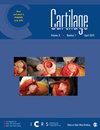软骨细胞分解过程中内质网应激与氧化应激的相互作用
IF 2.7
4区 医学
Q1 ORTHOPEDICS
引用次数: 0
摘要
目的氧化应激和内质网(ER)应激通过产生催化蛋白酶和促进软骨细胞衰老,在破坏软骨细胞的平衡方面发挥着关键作用,从而导致骨关节炎(OA)的进展。尽管它们之间存在密切的相互作用,但人们对其潜在的分子机制仍然知之甚少。方法通过切除 5 天大的 C57BL/6J 小鼠的股骨远端和胫骨近端,从其关节软骨中获得初级软骨细胞。使用妥卡霉素诱导原代软骨细胞产生ER应激。结果单环霉素诱导的ER应激导致原代软骨细胞中活性氧(ROS)和催化蛋白酶(包括MMP13和Adamts5)的产生增加,并且主要依赖于NADPH氧化酶(NOX)系统。ER 应激直接增加了 NOX2、NOX3、NOX4 和 p22phox 的表达。具体来说,蛋白激酶 RNA 样 ER 激酶(PERK)途径参与 NOX4 和 p22phox 的表达,肌醇需要酶 1 α(IRE1α)途径参与 NOX2 和 NOX3 的表达,激活转录因子 6(ATF6)途径影响 NOX3 在软骨细胞中的表达。相反,抑制 NOX 功能可显著减少 ER 应激传感器相关信号传导和软骨细胞分解,从而减缓手术诱导的体内 OA 的进展。本文章由计算机程序翻译,如有差异,请以英文原文为准。
The Interplay Between Endoplasmic Reticulum Stress and Oxidative Stress in Chondrocyte Catabolism
ObjectiveOxidative stress and endoplasmic reticulum (ER) stress play pivotal roles in disrupting the homeostasis of chondrocytes by producing catalytic proteases and enhancing chondrocyte senescence, consequently contributing to the progression of osteoarthritis (OA). Despite their close interaction, the underlying molecular mechanisms remain poorly understood. Here, we show that ER stress and oxidative stress reciprocally modulate each other to promote cartilage degradation.MethodsPrimary chondrocytes were obtained from the articular cartilage of 5-day-old C57BL/6J mice by excising distal femur and proximal tibia. Tunicamycin was applied to induce ER stress in primary chondrocytes. Surgical OA was induced in 12-week-old male C57BL/6J mice by destabilizing the medial meniscus (DMM).ResultsTunicamycin-induced ER stress led to an increase in the production of reactive oxygen species (ROS) and catalytic proteases, including MMP13 and Adamts5, in primary chondrocytes, and it was primarily dependent on the NADPH oxidase (NOX) system. ER stress directly increased the expression of NOX2, NOX3, NOX4, and p22phox. Specifically, the protein kinase RNA-like ER kinase (PERK) pathway is involved in the expression of NOX4 and p22phox, the inositol-requiring enzyme 1 alpha (IRE1α) pathway in NOX2 and NOX3 expression, and the activating transcription factor 6 (ATF6) pathway influences NOX3 expression in chondrocytes. Conversely, inhibiting NOX function significantly reduced both ER stress sensor–related signaling and chondrocyte catabolism, thereby decelerating the progression of surgically induced OA in vivo.ConclusionsOur findings highlight the positive feedback loop between ER stress and oxidative stress in OA pathogenesis, suggesting that targeting NOX isoforms is a promising therapeutic strategy for OA.
求助全文
通过发布文献求助,成功后即可免费获取论文全文。
去求助
来源期刊

CARTILAGE
ORTHOPEDICS-
CiteScore
6.90
自引率
7.10%
发文量
80
期刊介绍:
CARTILAGE publishes articles related to the musculoskeletal system with particular attention to cartilage repair, development, function, degeneration, transplantation, and rehabilitation. The journal is a forum for the exchange of ideas for the many types of researchers and clinicians involved in cartilage biology and repair. A primary objective of CARTILAGE is to foster the cross-fertilization of the findings between clinical and basic sciences throughout the various disciplines involved in cartilage repair.
The journal publishes full length original manuscripts on all types of cartilage including articular, nasal, auricular, tracheal/bronchial, and intervertebral disc fibrocartilage. Manuscripts on clinical and laboratory research are welcome. Review articles, editorials, and letters are also encouraged. The ICRS envisages CARTILAGE as a forum for the exchange of knowledge among clinicians, scientists, patients, and researchers.
The International Cartilage Repair Society (ICRS) is dedicated to promotion, encouragement, and distribution of fundamental and applied research of cartilage in order to permit a better knowledge of function and dysfunction of articular cartilage and its repair.
 求助内容:
求助内容: 应助结果提醒方式:
应助结果提醒方式:


